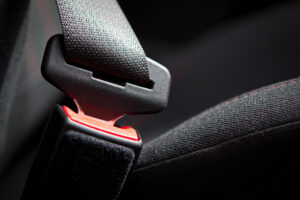
Industry feedback results in OEM changing owner’s manuals
By onAnnouncements | Collision Repair | Repair Operations
Industry feedback has led to seatbelt repair changes in Hyundai Genesis and Kia owner’s manuals, Aaron Schulenburg said during a Society of Collision Repair Specialists (SCRS) open meeting Tuesday night.
Schulenburg said SCRS was contacted by a member regarding repair statements in the OEMs’ manuals.
The manuals state replacement should always be made of “the entire seat belt assembly after it has been worn in an accident, even if damage to webbing or assembly is not apparent.”
Questions about the statements have been circling the repair industry for years and Kia even clarified its statements in February 2022 following an I-CAR Repairability Technical Support (RTS) inquiry.
Kia’s 2022 clarification on the I-CAR RTS site said, “After a collision, be sure to inspect the seatbelt system if it works normally. If not working normally, replace the seatbelts with new ones.”
The clarification also notes that the statement is not specified in Kia service manuals or body repair manuals.
However, the statements remained in the owner’s manuals.
Schulenburg said this creates a conflict for collision repairers.
“There’s engineering instruction that’s published to the consumer that says this is what we have to do,” Schulenburg said. “But there’s also a recognition on our part; our jobs would be easier if repairs were less invasive, especially when logic maybe doesn’t necessarily dictate that it’s necessary. If this is published, we probably have to do it to be able to serve the consumer well in what’s expected of us.”
He added that not following the statements could also be a liability issue for repairers.
He said this is an example of where advocacy is important for the industry. Associations, such as SCRS, are able to lean on relationships it’s built with OEMs to ask these types of questions, Schulenburg said.
“Our experience is that the automakers are often very responsive in their ability to turn around and look at something and identify if there’s a different way to instruct, to get the outcome that they’re looking for to keep consumers safe and still produce proper repairs,” he said.
He added that SCRS was able to engage in conversations with Hyundai regarding the seatbelt statements and Hyundai responded with a three-stage approach:
Minor Accidents – Stage 0 (no restraint deployment)
-
- No pretensioner (belt)/air bag deployment due to minor accident
- Seatbelt replacement is not required
Minor Accidents – Stage 1 (Pretensioners only deployed)
-
- Minor accidents can be protected only by deploying the pretensioner (belt)
- Need to replace deployed seatbelt
Minor accidents – Stage 2 (Pretensioner and air bag deployment)
-
- Although the accident is minor, pretensioner (belt)/air bag needs to be deployed
- Need to replace deployed seatbelt/air bag
Hyundai said it will publish the statement in all owner’s manuals going forward, Schulenburg said. The OEM also provided a document with a signature at the bottom saying repairers can use the three-stage approach as a supplement until the owner’s manual procedure is changed.
“I think this is a really important example of where industry feedback can result in positive change that creates less invasive repairs but still keeps us compliant,“ Schulenburg said.
He said members are always welcome to contact SCRS with similar questions.
“I’m grateful that we have the report with automakers to bring our member perspectives to them, and that they listen and respond,” Schulenburg said. “Our members are always welcomed to utilize SCRS as a conduit for these types of questions, and other well-established industry resources such as I-CAR’s RTS website.”
IMAGES
Photo courtesy of AndrewJShearer/iStock
